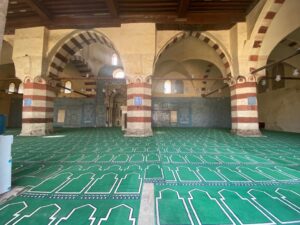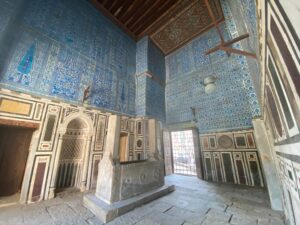On Bab el-Wazir Street, el-Darb el-Ahmar district stands the Aq Sunqur Mosque, which was built in 1347 by Prince Shams Eddin Aq Sunqur, a Mamluk of al-Nasir Muhammad ibn Qalawun.
Antiquities inspector Mohamed Khalil told the Egyptian Mail that Aq Sunqur, who later became the Sultan’s son-in-law, held many important military positions. He later took over Tripoli during the reign of el-Saleh Ismail. He died in 1347 and was buried in a mausoleum annexed to his mosque. The tomb of Sultan Ala’a ad-Din Kujuk, son of Sultan Naser Mohamed ibn Qalawun, is in another mausoleum.
In 1651, during the Ottoman period, an earthquake hit the country and damaged many parts of the mosque, whereupon Ottoman prince Ibrahim Agha Mustahfizan ordered restoration work in 1654, rebuilding the roof and arcades, and adding columns to support the southern prayer hall. He renewed the qibla wall by covering it with glazed blue tiles, hence the epithet ‘Blue Mosque’. The tiles are decorated with floral and cypress-tree motifs. Mustahfizan’s final resting place is in this mosque and his burial chamber is also covered with blue tiles.
It was Mustahfizan who learned that one of the pious men dreamt that Prophet Mohamed (Peace Be Upon Him) was praying in the mosque, which is why this place of worship is known as the ‘Mosque of the Dream’.
The mosque was damaged in the 1992 earthquake and was closed for renovation. Between 2009 and 2012, the Aga Khan Trust for Culture (AKTC) brought the mosque back to its former condition.
The mosque consists of an open courtyard surrounded by four riwaqs (porticos), of which the largest is that of the qibla. Its mihrab is made of marble and is regarded as one of the finest in Egypt.
A noteworthy detail is the black basalt doorstep bearing pharaonic inscriptions at the entrance to the mosque.
In February this year, Secretary General of the Supreme Council of Antiquities Mostafa Waziry inaugurated the Darb el-Ahmar route in Historic Cairo which is listed as a UNESCO heritage site.
The Blue Mosque is one of twelve stops on the two-kilometre route, which starts at the visitor centre in Al-Azhar Park, where you can watch a video in many languages about the path, the history of el-Darb el-Ahmar and structures of archaeological interest.
Visitors riding in eco-friendly electric cars from Al-Azhar Park will be taken past the mud brick eastern Ayyubid Wall, built by the founder of Cairo, Gawhar Al Siqili. Further along the route is the Tarabay al-Sharifi Complex, completed in 1516 with its helmet-shaped dome dating back to the Circassian Mamluk era.
The route includes Al-Saleh Talaa Mosque, the last mosque built in the Fatimid era and the oldest hanging mosque in Egypt.
There are sitting areas at certain points on the route with panels and display boards with QR codes so that you can find out more details about the building you find yourself in front of.
Co-ordination is underway between the Ministry of Tourism and Antiquities, the Ministry of Housing, Utilities and Urban Communities, and Cairo Governorate to make provision for handicraft shops, notably tent-makers, for which Historic Cairo was once famous.
Tickets to go along the path cost LE20 for Egyptians, LE10 for Egyptian students, LE120 for non-Egyptians and LE60 for non-Egyptian students.
For further information about the route, please log on to https://aldarbalahmar.com








Discussion about this post